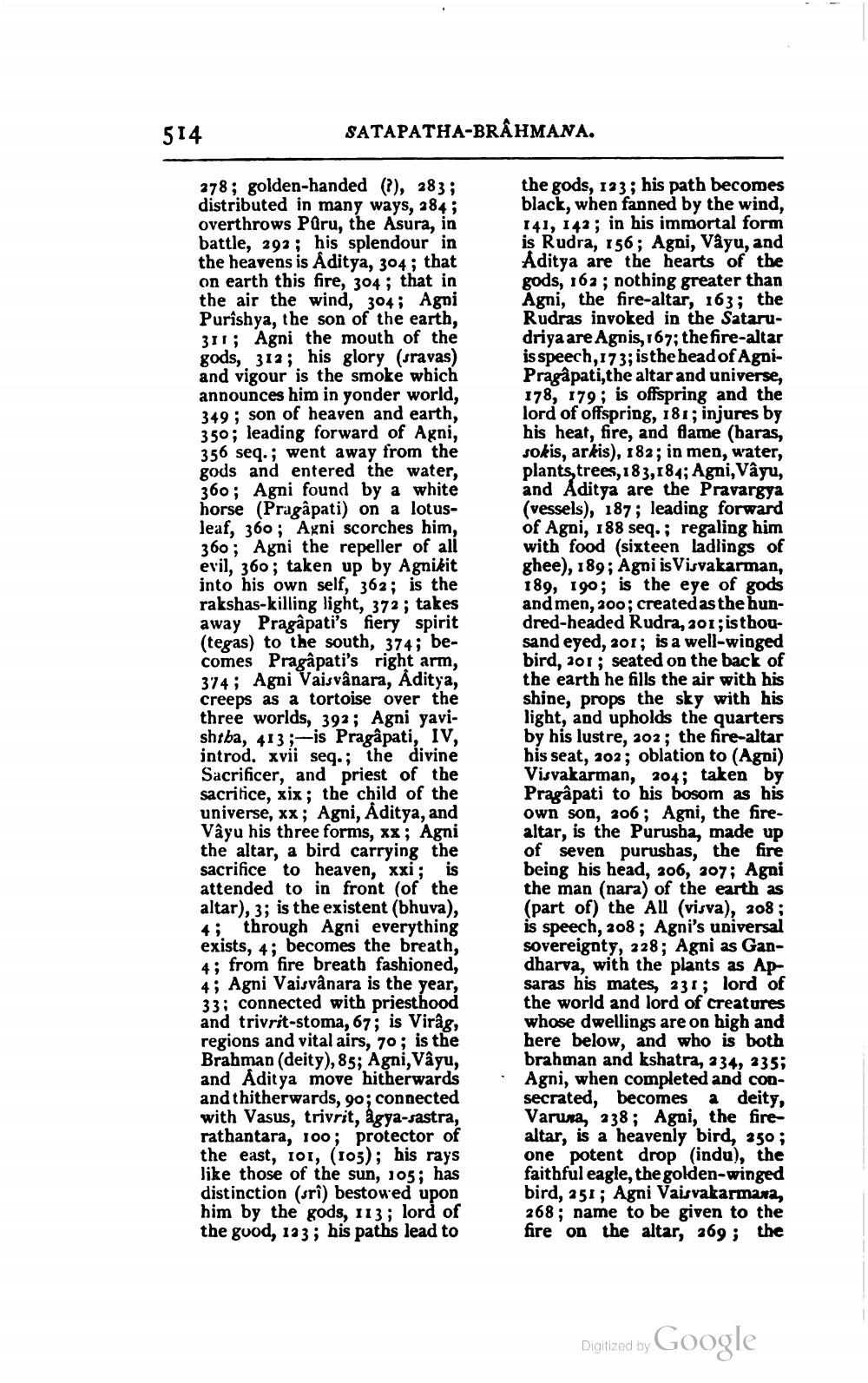________________
514
SATAPATHA-BRAHMANA.
278; golden-handed (?), 283; distributed in many ways, 284; overthrows Pûru, the Asura, in battle, 292; his splendour in the heavens is Aditya, 304; that on earth this fire, 304; that in the air the wind, 304; Agni Purishya, the son of the earth, 311; Agni the mouth of the gods, 312; his glory (sravas) and vigour is the smoke which announces him in yonder world, 349; son of heaven and earth, 350; leading forward of Agni, 356 seq.; went away from the gods and entered the water, 360; Agni found by a white horse (Pragâpati) on a lotusleaf, 360; Agni scorches him, 360; Agni the repeller of all evil, 360; taken up by Agnikit into his own self, 362; is the rakshas-killing light, 372; takes away Pragâpati's fiery spirit (tegas) to the south, 374; becomes Pragâpati's right arm, 374; Agni Vaisvânara, Aditya, creeps as a tortoise over the three worlds, 392; Agni yavishtba, 413;-is Pragâpati, IV, introd. xvii seq.; the divine Sacrificer, and priest of the sacrifice, xix; the child of the universe, xx; Agni, Aditya, and Vâyu his three forms, xx; Agni the altar, a bird carrying the sacrifice to heaven, xxi; is attended to in front (of the altar), 3; is the existent (bhuva), 4; through Agni everything exists, 4; becomes the breath, 4; from fire breath fashioned, 4; Agni Vaisvânara is the year, 33: connected with priesthood and trivrit-stoma, 67; is Virâg, regions and vital airs, 70; is the Brahman (deity), 85; Agni, Vâyu, and Aditya move hitherwards and thitherwards, 90; connected with Vasus, trivrit, agya-sastra, rathantara, 100; protector of the east, 101, (105); his rays like those of the sun, 105; has distinction (sri) bestowed upon him by the gods, 113; lord of the good, 123; his paths lead to
the gods, 123; his path becomes black, when fanned by the wind, 141, 142; in his immortal form is Rudra, 156; Agni, Vâyu, and Aditya are the hearts of the gods, 162; nothing greater than Agni, the fire-altar, 163; the Rudras invoked in the Satarudriya are Agnis, 167; the fire-altar is speech,173; is the head of AgniPragâpati,the altar and universe, 178, 179; is offspring and the lord of offspring, 181; injures by his heat, fire, and flame (baras, sokis, arkis), 182; in men, water, plants, trees,183,184; Agni, Vâyu, and Aditya are the Pravargya (vessels), 187; leading forward of Agni, 188 seq.; regaling him with food (sixteen ladlings of ghee), 189; Agni is Visvakarman, 189, 190; is the eye of gods and men, 200; created as the hundred-headed Rudra, 201; is thousand eyed, 201; is a well-winged bird, 201; seated on the back of the earth he fills the air with his shine, props the sky with his light, and upholds the quarters by his lustre, 202; the fire-altar his seat, 202; oblation to (Agni) Visvakarman, 204; taken by Pragâpati to his bosom as his own son, 206; Agni, the firealtar, is the Purusha, made up of seven purushas, the fire being his head, 206, 207; Agni the man (nara) of the earth as (part of) the All (visva), 208; is speech, 208; Agni's universal sovereignty, 228; Agni as Gandharva, with the plants as Apsaras his mates, 231; lord of the world and lord of creatures whose dwellings are on high and here below, and who is both brahman and kshatra, 234, 235; Agni, when completed and consecrated, becomes a deity, Varuna, 238; Agni, the firealtar, is a heavenly bird, 250; one potent drop (indu), the faithful eagle, the golden-winged bird, 251; Agni Vaisvakarmana, 268; name to be given to the fire on the altar, 269; the
Digitized by
Google




